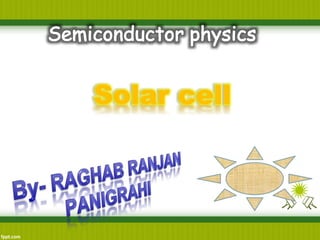
Presentation on solar cell
- 1. Solar cell
- 2. Contents
- 3. Introduction to Solar Cells A solar cell, or photovoltaic cell, is an electrical device that converts the energy of light directly into electricity by the photovoltaic effect, which is a physical and chemical phenomenon. It is a form of photoelectric cell, defined as a device whose electrical characteristics, such as current, voltage, or resistance, vary when exposed to light. Individual solar cell devices can be combined to form modules, otherwise known as solar panels. In basic terms a single junction silicon solar cell can produce a maximum open-circuit voltage of approximately 0.5 to 0.6 volts. Solar cells are described as being photovoltaic, irrespective of whether the source is sunlight or an artificial light. They are used as a photodetector (for example infrared detectors), detecting light or other electromagnetic radiation near the visible range, or measuring light intensity. The operation of a photovoltaic (PV) cell requires three basic attributes: The absorption of light, generating either electron-hole pairs or excitons. The separation of charge carriers of opposite types. The separate extraction of those carriers to an external circuit. In contrast, a solar thermal collector supplies heat by absorbing sunlight, for the purpose of either direct heating or indirect electrical power generation from heat. A "photoelectrolytic cell" (photoelectrochemical cell), on the other hand, refers either to a type of photovoltaic cell (like that developed by Edmond Becquerel and modern dye-sensitized solar cells), or to a device that splits water directly into hydrogen and oxygen using only solar illumination.
- 4. All the aspects presented in this chapter will be discussed in greater detail in the following chapters. The working principle of solar cells is based on the photovoltaic effect, i.e. the generation of a potential difference at the junction of two different materials in response to electromagnetic radiation. The photovoltaic effect is closely related to the photoelectric effect, where electrons are emitted from a material that has absorbed light with a frequency above a material-dependent threshold frequency. In 1905, Albert Einstein understood that this effect can be explained by assuming that the light consists of well defined energy quanta, called photons. The energy of such a photon is given by E = hν, (3.1) where h is Planck’s constant and ν is the frequency of the light. For his explanation of the photoelectric effect Einstein received the Nobel Prize in Physics in 1921 . The photovoltaic effect can be divided into three basic processes:
- 5. 1. Generation of charge carriers due to the absorption of photons in the materials that form a junction. 2. Subsequent separation of the photo-generated charge carriers in the junction. . 3. Collection of the photo-generated charge carriers at the terminals of the junction.
- 6. There are basically 3 types of solar cell technology Discrete cell technology Integrated thin film techonology Multicrystalline silicon techology
- 7. Construction It essentially consists of a silicon PN junction diode with a glass window on top surface layer of P material is made extremely thin so, that incident light photon’s may easily reach the PN junction. Working of solar cell 1) Solar cell works under the principle of photovoltaic effect-when light is incident on ‘P-N’ junction a potential gets developed across the junction, this potential is capable of driving a current through the circuit. 2) Hence light energy is getting converted to electrical energy. 3) Here electrons absorbs photons having energy greater than the band gap energy hence they can make transition from the valence band to the conduction band & hence contributes current. 4) The wavelength of light is given by the relation, Eg=h=hc/λ=1.24
- 8. The very first benefit of using this technology is that solar energy is renewable. This is a 100% environment-friendly. Contrary to fossil fuels, this technology is not going to release any greenhouse gases, harmful agents, volatile material or carbon dioxide into the environment. Solar panels are highly durable and reliable. These systems don’t have any moving systems and hence they don’t require any replacement.
- 9. The main disadvantage of solar cell is the initial cost. Most types of solar cell require large areas of land to achieve average efficiency. Air pollution and weather can also have a large effect on the efficiency of the cells. The silicon used is also very expensive and the solar cells can only ever generate electricity during the daytime. Another con to Solar cell technology is that the efficiency level of this technology is low. The most efficient solar power system gives you an efficiency of not more than 40%. This means that the rest of the 60% power of sunlight is not harnessed. The most important thing that is necessary is the sky should be clear so that sunlight can fall on the solar cell and we can get electricity.
- 10. Rural electrification: The provision of electricity to rural areas derives important social and economic benefits to remote communities throughout the world like power supply to remote houses, electrification of the health care facilities, irrigation and water supply and treatment. Ocean navigation aids: Many lighthouses are now powered by solar cells. Telecommunication systems: radio transceivers on mountain tops are often solar powered. Solar cells are often electrically connected and encapsulated as a module. These modules often have a sheet of glass on the front (sun up) side, allowing light to pass while protecting the semiconductor wafers from climate conditions. Solar cells are also usually connected in series in modules, creating an additive voltage.